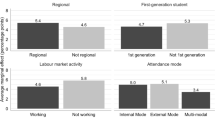Abstract
Because of the radical reorientation of financial aid policies in the eighties, loan indebtness and the amount of federal subsidy of loans have increased dramatically. Paralleling these developments has been the growth of the proprietary sector of postsecondary education and the use of federal-supported financial aid by this sector's students. This article examines the impact of current financial aid policies on different sectors. Evidence appears clear that new policy is required to serve equity and human and social capital development. The success of the proprietary sector in growing its market share at the expense of other sectors—in particular, community colleges—provides some useful lessons about aggressive recruiting.
Similar content being viewed by others
References
Cheit, E. F. (1971).The New Depression in Higher Education. New York: McGraw-Hill Book Company.
College Board (1983).Trends in Student Aid. Washington, DC: Author.
College Board (1985).Trends in Student Aid. Washington, DC: Author.
College Board (1987).Trends in Student Aid. Washington, DC: Author.
Gladieux, L. E., and Wolanin, T. R. (1976).Congress and the Colleges. Lexington, MA: Lexington Books, Inc.
Hodgkinson, H. L. (1985).All One System: Demographics of Education; Kindergarten through Graduate School. Washington, DC: The Institute for Educational Leadership, Inc.
Kominski, R. (1987).School Enrollment—Social and Economic Characteristics of Students: October 1983 (Report of Bureau of Census, U.S. Department of Commerce, Series P-20, No. 413). Washington, DC: U.S. Government Printing Office.
Lee, J. B. (1985).The Distribution of Student Financial Aid: Trends Among the Postsecondary Sectors. Washington, DC: American Council on Education, Division of Policy Analysis and Research (ERIC Document Reproduction Service No. 260 671).
Moore, R. W. (1987, June).Proprietary Schools: Issues in Access and Aid. Paper presented at the fourth annual meeting of the NCHELP/NASSGP Research Network Conference.
Moran, M. (1986).Student Financial Aid and Women (ASHE-ERIC Higher Education Report 5). Washington, DC: Association of Higher Education.
National Center for Education Statistics (1978).Enrollments and Programs in Noncollegiate Postsecondary Schools, 1978. Washington, DC: U.S. Government Printing Office.
National Center for Education Statistics (1982).Postsecondary Schools with Occupational Programs Survey. Washington, DC: U.S. Government Printing Office.
National Center for Education Statistics (1988).Digest of Education Statistics, 1988. Washington, DC: U.S. Government Printing Office.
National Institute of Independent Colleges and Universities (1980).Federal Student Assistance and Categorical Programs. Washington, DC: Author.
National Institute of Independent Colleges and Universities (1982).Postsecondary Schools with Occupational Programs Survey. Washington, DC: Author.
Office of Educational Research and Improvement, Department of Education (1987).The Condition of Education: A Statistical Report. Washington, DC: U.S. Government Printing Office.
Author information
Authors and Affiliations
Rights and permissions
About this article
Cite this article
Andrew, L.D., Russo, R. Who gets what? Impact of financial aid policies. Res High Educ 30, 471–483 (1989). https://doi.org/10.1007/BF00992198
Received:
Issue Date:
DOI: https://doi.org/10.1007/BF00992198




